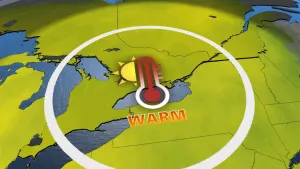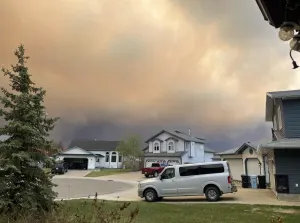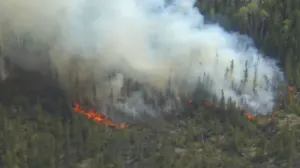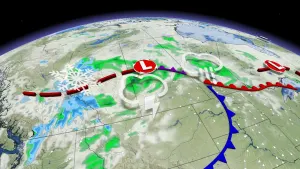
Astronomers worried about too many satellites lighting up the sky
On the night of Nov. 18, Cliff Johnson, an astronomy researcher at Northwestern University, was using the Dark Energy Camera on a telescope at the Cerro Tololo Inter-American Observatory in Chile to search for nearby dwarf galaxies.
In order to capture the light of faint, distant objects, the camera needs to take long-exposure images.
At first, Johnson noticed the streak of a meteor in one image. And then a plane. Nothing unusual. But then he noticed a train of long, seemingly inexplicable streaks.
"At first, I was just trying to figure out, 'What is this?' And then I put two and two together and thought, 'Oh right, this is probably Starlink," said Johnson. "And it was the predicted orbit for that whole train."
Johnson's observing run had been photobombed by SpaceX's 60 Starlink satellites, launched as part of the company's lofty goal to provide internet service to every part of the world.
This was the second launch of 60 Starlink satellites. But the 120 satellites now in orbit is really just a drop in the bucket: The company has permission to launch 12,000 satellites in total — and has asked to launch 30,000 more.
That would be roughly eight times more than are already in orbit.
It has astronomers deeply concerned.
ASTRONOMICAL COMMUNITY REACTS
All satellites have reflective surfaces, including a solar panel. When sunlight reflects off them, they shine periodically in the night sky.
While SpaceX's Starlink network currently stands as the most ambitious — and plentiful — satellite constellation, it isn't the only one.
Amazon plans to launch more than 3,000 of it own satellites; Boeing has applied for anywhere between 1,396 and 2,956; and even Canada has committed to launching close to 300 Telesat satellites.
Following the first Starlink launch in May, astronomers were shocked at just how visible their train of lights were. While over time the satellites would reach a higher altitude, reducing the brightness, astronomical organizations were quick to respond.

This image is composed of 300 short, 13-second exposures taken within 70 minutes from Waldenburg, Germany, on the night of the Perseids meteor shower in August 2018, before the launch of 120 Starlink satellites. Most of the noticeable lines are made from satellites reflecting sunlight from below the horizon. (Eckhard Slawik)
The International Dark-Sky Association (IDA), a non-profit organization dedicated to protecting the night sky, released a statement: "The number of low Earth orbit satellites planned to launch in the next half-decade has the potential to fundamentally shift the nature of our experience of the night sky. IDA is concerned about the impacts of further development and regulatory launch approval of these satellites."
The International Astronomical Union (IAU) and the American Astronomical Society (AAS) also weighed in with statements of their own.
But so too did SpaceX CEO Elon Musk: he promised to look into the reflectivity of the satellites, known as albedo.
NOTHING NEW
Satellite constellations aren't anything new; they've been around for decades. (The GPS in your devices work using such a constellation). However, these networks were typically made up of dozens of satellites — not thousands.
And they've never affected astronomers quite like the Starlink network has.
"It was pretty unlucky, I think, that we happened to be pointing … right where the train came across," said Johnson. "It was pretty shocking to see the entire train come across in our webcam view and later see the trails on the image that we took."
As a result, at least part of that imaging run will have some data lost.
"It isn't great for us, but there are ways to try to get around it," said Johnson.
Still, he is concerned by the overall trend.
"This is just the beginning; this is after two sets of satellites. And this is going to become a much more frequent incident."
BILLION-DOLLAR THREAT
At a time when more large-scale telescopes are being built, the potential of building constellations consisting of tens of thousands of satellites could jeopardize not just a hobby, but astronomical organizations probing the depths of our universe.

Astronomers at Lowell Observatory in Arizona took this image on the night after SpaceX launched 60 satellites. The diagonal lines running across the image are trails of reflected light left by more than 25 satellites as they passed through the telescope's field of view. (Victoria Girgis/Lowell Observato)
One such telescope is the Large Synoptic Survey Telescope (LSST), a $1 billion, 8.4-metre, ground-based telescope currently under construction in Cerro Pachón, Chile. Once completed in 2020, it will become the most important wide-field imager ever built, helping astronomers better understand galaxy formation, dark matter and more.
But if there are 30,000 satellites streaking through its data, it could seriously threaten research.
Jeff Hall, an astronomer at Lowell Observatory in Flagstaff, Ariz., and the chair for the American Astronomical Society's Committee on Light Pollution, Radio Interference, and Space Debris, said he and others from the AAS are currently trying to assess the impact on professional astronomy. They are currently engaged in discussions with SpaceX.
While there have been suggestions to reduce the satellites' albedo by painting them black, it's not that simple: black absorbs light and could damage the satellites' sensitive instruments.

Astronomer Alan Dyer imaged the Starlink satellites from southern Alberta on the night of May 26, as they travelled through the Big Dipper. (Submitted by Alan Dyer)
When it comes to regulating an increasingly crowded Earth orbit, Hall says it'll have to be an international effort, to ensure that everyone gets on board with set global standards. But is it already too late?
"You could probably make an argument that, yeah, the train has left the station," said Hall. "But my feeling is, the situation is what it is — and you just work with the reality and work with that the best that you can."
Mary Beth Laychak, outreach program manager at Canada-France-Hawaii Telescope, isn't only concerned about optical telescopes, but also those working with other wavelengths.
"While a lot of the focus has been on the impact for optical astronomy, I know astronomers who work in the submillimeter and radio wavelengths that are very concerned about the impact on their work," she said in an email. "The satellites broadcast in the wavelengths that high-frequency radio telescopes are sensitive to."
In an email statement to CBC News, SpaceX said it is co-ordinating with the National Radio Astronomy Observatory to work toward a solution. The company said it is also working with astronomical organizations around the world to ensure the impact to their work is minimally affected.
In the meantime, SpaceX is set to launch another 60 satellites next month.
"I think the goals that SpaceX lays out, of providing internet access to underserved areas — that's a worthwhile goal," said Hall. "It's just that it caught us by surprise. I think it caught SpaceX by surprise."
Original story by Nicole Mortillaro, published on CBC.ca









